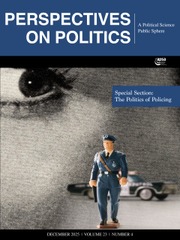We welcome the opportunity to engage with Margaret Perez Brower in the arena of domestic violence policy and we appreciate her thoughtful assessment of our scholarship. We all agree that domestic violence (DV) policy needs more time and attention in the fields of political science and public policy.
Perez Brower raises constructive points about our book and avenues for future research agendas. First, she raises the issue of whether punitive punishment of DV is effective in protecting women and saving lives. As influential legal feminists have argued before, punitive responses to DV are not typically an effective way of addressing the holistic environment that gives rise to abuse. But in some cases, there are abusers who pose imminent and direct lethal threats to their victims and every effort has to be made to keep them away from their victims, including arrest and incarceration. Yet these punitive solutions disproportionately harm communities of color; for example, in our book, we discuss the all-too-common pattern of dual arrests where Black women call law enforcement for help against an abuser and they are also arrested. There are other ways of trying to prevent escalation to serious injury and lethal violence. One way that we discuss in our final chapter is to encourage police departments to use lethality assessments—a set of questions posed to victims about their environments—when responding to domestic violence calls. Studies have shown that lives are saved when lethality assessments are used to connect victims to support services at the time of abusive events. We also discuss the need to expand the definition of DV to include coercive control and to consider the need for greater restrictions on the availability of unserialized, privately assembled ghost guns used to commit DV firearm violence.
We concur with Perez Brower that no story regarding firearm policy in the United States is complete without an analysis of the NRA’s role in the policy-making process. First, we cite Matthew Lacombe’s work, Kristin Goss’s work, and Sierra Smucker’s key study on the role of the NRA and other interest groups and legislative advocates in either pushing forward or blocking DV firearm legislation at the state and federal levels. We also spend considerable time in Chapters 2, 3, and 4 illustrating how the convergence of the NRA’s agenda on gun rights with the Republican Party’s intensifying conservative ideology created a powerful synergy to oppose DV firearm laws. We also note that despite the weakening of the NRA in its financial and legislative reach in recent years, the Republican Party has empowered Second Amendment Rights voices to the level that the party’s policies almost wholly reflect those of the NRA. Still, there are moments in policymaking, such as the 2022 Bipartisan Safer Communities Act (BSCA), where Congress overcomes these barriers to make real changes—such as closing the boyfriend loophole that had enabled dating partners who were abusive to access guns. Additionally, in 2024, the conservative-dominated Supreme Court ruled in United States v. Rahimi to uphold the key VAWA provision which prevented individuals under domestic violence restraining orders from owning or possessing guns.
We look forward to further engaging with Perez Brower and other scholars within political science and public policy in this important political and policy domain.


